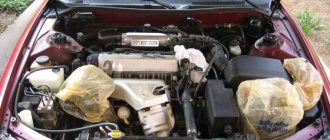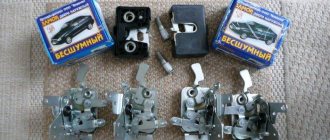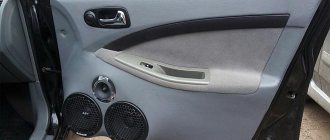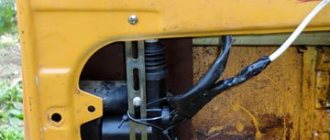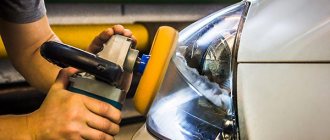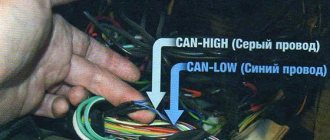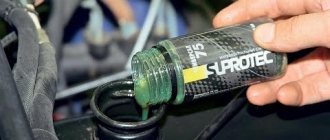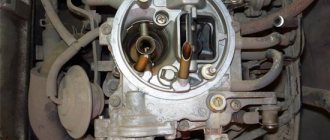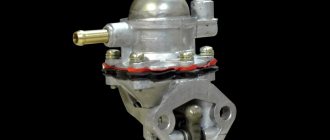Those motorists who regularly look after their vehicle and monitor its proper technical condition are right. Proper care can extend the life of your car and keep it looking its best. From time to time, the hinges on the car may begin to creak and the locks may jam. This is a natural process caused by the gradual wear of the factory lubricant. The lubricant has a certain service life, and under the influence of negative internal and external factors, the service life of the lubricant is reduced even more intensely. Therefore, one of the car owner’s tasks is to periodically apply new lubricant, which will eliminate unpleasant squeaks and also allow all elements to open easily and without problems as needed. Motorists want to know what is the best way to lubricate car door hinges and existing locks. The market offers a wide variety of various tools that are potentially suitable for solving such problems. But you need to treat them carefully so as not to damage the car even more.
Choosing the right lubricant for car door hinges and locks.
Why is lubrication required?
Each motorist uses his own vehicle with varying intensity in everyday life. Some travel by car literally 1-2 times a week, while others travel regularly. How often the driver will open and close the doors depends on the frequency of use of the car. The doors have mechanisms using rubbing elements. They are the ones that can wear out quickly. Under the negative influence of dirt, dust, water and moisture, the situation only gets worse. Soon the malfunctions manifest themselves in the form of squeaking and unpleasant noise that the driver has to hear every time the door opens and closes.
It is extremely inconvenient and unpleasant if the door jams, cannot close properly the first time, and the hinges creak. This is irritating to the ear, but also indicates wear and tear on the rubbing parts. Ignoring the problem can lead not only to an increase in the noise level, but even to complete breakdown of the mechanisms. Fixing such problems is much more expensive than simply purchasing a good lubricant and treating vehicle parts with it. Timely and proper care plays a key role in ensuring the comfort of the driver himself, as well as in reducing the cost of repairs and maintenance of his car. The driver just needs to make it a rule to periodically inspect the hinges and locks and lubricate them with high-quality materials. This is what will allow you to avoid unpleasant situations and expensive repairs of mechanisms.
Why not LITOL, SOLIDOL, WD-40 and SILICONE?
YES, everything is simple, as I wrote above, they are all friction modifiers. That is, they reduce friction.
LITOL – SOLIDOL and SILICONE . If you smear them, then the door will not be held in special tubercles, but from any breeze it will close or swing open, sliding perfectly. Of course, when opened, the creaking will go away, but this is not at all what we need. Moreover, dirt and dust adhere perfectly to all these lubricants, and then this mixture acts as an abrasive, the plastic inserts wear out very quickly
WD-40 (you can read how to make it yourself here ) is generally an excellent solvent, it also lubricates well (of course not as effectively as the top opponents), but it can easily corrode seals. So this is also not our option.
Types of lubricants and their features
With the current assortment on the market, the driver does not need to try to create some kind of lubricant at home, using improvised materials used in everyday life. Therefore, forget about vegetable oils and other similar products. You don't need them when it comes to car maintenance. Also, the problem of creaking hinges and jamming of locks does not need to be solved with the help of automobile workshops. It’s worth visiting them only when the condition has reached a critical level and some elements need to be replaced, otherwise the doors simply won’t open anymore or will very soon fall off their fastenings. If the situation is not critical, but you definitely need to lubricate the hinges and locks, then just visit an automotive chemical store. There is a huge range of all kinds of products available here. From this variety, you can easily choose a lubricant that will meet your requirements in terms of price, quality and characteristics.
But there is no need to rush into making a choice, relying solely on advice from forums or the opinion of the seller. It is possible that a store employee just needs to sell a stale item, and the advice of another motorist is based on the characteristics of his own car, which does not quite correspond to the nuances of your vehicle. Lubricants for car door hinges and locks contain various components, additives, oils and thickeners. They help expand the functionality and achieve the desired characteristics for the base substance. Depending on the parameters, different types of lubricants are distinguished:
- Based on the composition, lubricants can be divided into liquid, semi-solid and structural;
- Depending on the method of use, there are universal, motor and transmission;
- Based on the substances and base components used, lubricants are divided into vegetable, mineral, synthetic and semi-synthetic.
If you need a lubricant that is perfect for the locks and doors of your car, then experts distinguish two more groups, which include polymer and mineral lubricants.
Polymer
Many experts and motorists themselves are confident that, if necessary, it is best to use a silicone compound to lubricate hinges and locks. It is produced by a large number of leading manufacturers of automotive chemicals, including Xado, Turtle Wax, etc. The advantage of a silicone base is the ability to withstand heavy loads without losing its quality and performance characteristics. Silicone lubricants can easily withstand temperature loads down to -50 degrees Celsius. It is recommended to use silicone grease for processing door locks, since the composition is durable, has excellent adhesion properties and quickly adheres to the treated metal surface. As a result, a dense protective film is formed that can retain its properties for one or two seasons under conditions of adequate operating intensity. If the machine is used very often, it is better to lubricate it with silicone 2 times a season.
Silicone lubricants are offered in spray form, making their application as easy as possible. As soon as the protective film begins to thin, it is recommended to apply a new layer. Plus, the treatment should be carried out in winter after a thorough thorough wash of the vehicle. First, all hinges and locks are wiped with paper napkins, and then the bottle is sprayed with the product on all moving mechanisms between which friction occurs during the operation of the car. Sometimes silicone grease is sold in tubes, and the product itself has a paste-like appearance. Domestic manufacturers recommend using protective gloves in such situations. The paste must be gently but thoroughly rubbed into the locks and hinges.
There are also more advanced silicone lubricants, which contain synthetic oils and additives designed to resist wear. The modified product reduces friction in hinges and locks. Moreover, the users of such products themselves note that the effect lasts for quite a long time. When the solvent evaporates from the lubricant, a thick layer is formed that adheres well to the metal surface. It cannot be washed off with a directed stream of water, and therefore there is no need to renew the protection after each wash. Among the lowest quality polymer lubricants is technical petroleum jelly. In theory, it can be used to lubricate hinges and locks, which is what many motorists do. This product forms a protective layer on the surface with water-repellent properties, but Vaseline cannot work effectively for more than two to three weeks. You have to update it every 14 days or after washing the car. Plus, technical Vaseline is sold in tubes and has a thick structure, and therefore cannot be used to treat hard-to-reach areas.
Mineral
Polymer lubricants have many advantages in the form of good protection of hinges and locks, and prevention of rapid wear of moving parts. They are also destroyed by moisture. But in terms of resistance to leaching and strong heating, they show their weaknesses. Because of this, experts advise using lubricating greases that provide a longer lasting effect. Moreover, they are used before the winter period, since at this time moisture and water in the mechanisms are most active. A number of experts note that an excellent solution for treating doors is lithium grease, that is, a lithium-based lubricant. The simplest, but at the same time quite effective solution is the domestic Litol 24. There are also a number of imported analogues that cope with the tasks assigned to them no worse.
Lithium lubricants can effectively reduce friction between parts and perfectly remove excess moisture. But there are some doubts about the extent to which lithium products can provide anti-corrosion protection. If lithol or its analogue is applied in a thin layer, the composition can be quickly washed out, and therefore rust forms in these areas. In order for the product to effectively penetrate all locks and hinges, it is still better to give preference to lithium-based complex lubricants. A prominent representative is the composition from the Castrol company, which is called LMXLI. An analogue of lithium lubricants is a product based on molybdenum disulfide. We are talking about metal salt, which is used in many protective products for cars. Therefore, such lubricants can handle:
- engine;
- CV joints;
- bearings;
- transmission.
These materials are able to effectively resist moisture and rapid wear of the metal surfaces of locks and hinges due to their friction. But here, too, experts have found some shortcomings. If the air is very dusty, then solid particles will penetrate into the lubricant, significantly changing its initial physical and chemical properties. In this regard, it is better not to use products based on molybdenum disulfide if you need to treat locks on off-road vehicles. The compositions also leave behind greasy stains. It is recommended to work with them in a change of clothes, otherwise you risk complicating the task of removing traces of machine lubricant for yourself or your wife.
As practice shows, the most effective and efficient mineral-type lubricants are products from Castrol and Liqui Moly. The experts themselves explain their findings by saying that the lubricants contain adhesive and anti-wear additives that can significantly improve the properties of the material. But be prepared to pay a decent amount of money for them. If you don’t want to spend that kind of money or can’t, then there are more budget options that are somewhat inferior to the leaders in physical and chemical properties. Domestic motorists often use Fiol 8 and CV joint 4. Their high efficiency is due to the presence of a large amount of molybdenum disulfide in the composition.
Before applying any mineral lubricant to the surface of locks and hinges, be sure to remove all traces of moisture with paper napkins. This will eliminate the possibility of water crystals forming under the lubricant layer, which will begin to destroy the lubricant and then provoke corrosive processes on the metal. Only as a last resort is the use of graphite lubricants allowed. They contain an impressive amount of abrasive components, and therefore they will not be able to protect the same locks or hinges from wear. The opposite effect is observed, that is, a hole is formed due to friction of the metal and abrasive particles.
Graphite lubricants are suitable for long-term preservation of a vehicle that is left in a garage for a long time and not used. Graphite provides excellent protection against corrosion. The main reason for the active purchase of graphite lubricants is affordability. But such an idea should be categorically rejected. Buy more expensive, but safe and effective lubricants. Hinges and locks can be considered quite demanding parts in terms of selecting lubricants for them. There are some compounds the use of which should be categorically avoided. These include:
- WD40;
- solid oil and its analogues;
- spindle oil;
- lubricants of unknown origin.
By using such means, you take a serious risk. There are a lot of great solutions with which you can definitely cope with your tasks.
Correct ways
We will tell you about the best and most effective methods to open your car easily and in a short time. So, how to defrost if the lock is frozen after washing or any other procedure:
- You will need hot water bottles or a couple of bags of hot sand. You need to apply the heating pad directly to the lock and hold it for a couple of minutes. Sometimes this way the lock opens almost immediately. But in very severe frost this option may not work.
- A special “liquid key”, or lock defroster, will effectively open the lock. This gadget is battery-powered and has a retractable pin that heats up as soon as it is pulled out of the plastic casing. The pin needs to be inserted into the lock and it will warm it up in a minute.
- You can pour a small amount of pure alcohol or cologne into the lock. The alcohol will warm up the ice in the lock, and it will open in a couple of minutes. This is a fairly cheap and safe method that can be used in mild frost.
- A thin metal pin will help open almost any lock. It needs to be heated over a fire from a lighter and inserted into the hole in the lock. Quite an effective method, but you just need to try not to ruin the car’s paint.
- If you don’t have any special products at hand, you can try heating the lock with a regular hair dryer. You need to set it to “hot” mode and warm up the lock from the outside for a couple of minutes. It will defrost and open.
- If the lock needs to be opened very quickly, you can use WD-40. It contains kerosene and will help you open the lock almost instantly. It must be poured directly into the lock. However, it should be taken into account that the remnants of this liquid can clog the lock, and there will be problems the next time it is opened.
Attention!
As soon as the lock is opened using any of the above methods, it is necessary to pour moisture-displacing grease into the cylinder, which will dry the lock from the inside, and the water will not freeze next time.
When opening the lock, do not rush, otherwise you can damage both the lock and the car cover. And if the lock cylinder is damaged, then most likely it will need to be replaced - expensive repairs and a lot of nerves. Therefore, experienced car enthusiasts know that they need to prepare for winter in advance and stock up on everything necessary, lubricants and gadgets.
General requirements
Without focusing on a specific manufacturer or type of lubricant, when choosing a suitable composition for locks and hinges, a number of requirements should be presented to the product. They are common to all, and consist in ensuring that the lubricant has:
- viscous structure;
- high strength;
- resistance to work at low and high temperatures;
- good lubricating properties;
- stability of physical and chemical properties;
- resistance to mechanical stress;
- wear resistance;
- water-repellent characteristics;
- anti-corrosion resistance.
If the lubricant you choose meets all these criteria, you won’t have to worry about locks and hinges. They will be under reliable protection. But it will have to be periodically monitored and the layer of lubricant renewed as it wears out and becomes thinner. Here are a few examples of what products can be used when processing door hinges and locks.
How to properly lubricate hinges and locks?
You should not assume that the procedures for lubricating door hinges are simple and straightforward, as it may seem at first glance. Many car enthusiasts think that the whole process consists of applying a substance to rubbing surfaces
However, if you do not follow the correct lubrication technology, squeaking and other problems will disappear only for a while, but will soon make themselves felt again.
To achieve the desired effect, first clean the surfaces of dirt deposits. You can use an ordinary wide brush and gasoline, or even better, a rust converter.
After cleaning, begin applying lubricant. There is no need to process the entire loop; focus on the joining elements.
Remove excess grease with a clean rag. To distribute the material more efficiently, open and close the doors 10-20 times. After all the manipulations, the squeak should disappear. If this does not happen, you may have forgotten to lubricate all existing hinges or did not clean the surfaces well enough. The reason for the continued squeaking may also be sagging doors.
It is most convenient to apply lubricant to locks from an aerosol can with a thin tube. In this case, the product will immediately enter the mechanism. When it begins to flow out of the well, stop applying and wipe the lock cylinder with a dry cloth. Then insert the wrench and turn it several times to better distribute the lubricant.
Door hinges
Hinges are used quite often in vehicle design. This mainly concerns door mechanisms. There are several common options for which lubricant to use for your car's door hinges. Hinges are not the most demanding elements, but it is still better to know exactly what kind of lubricant should be used, and what is not recommended to lubricate with. Using the right lubricant, you will not encounter unpleasant squeaks or problems when opening and closing doors.
- Wurth 2000. A common and effective lubricant that falls into the synthetic category. Can be used when processing hinges, locks, gears, etc. Penetrates perfectly into cracks and gaps, forms a stable protective film;
- Multigliss from Molykote. A product with approximately the same properties as the previous lubricant. One of the best solutions in terms of price and quality. Although slightly inferior to Wurth in physical and chemical properties;
- Movil. An inexpensive but effective lubricant that can efficiently cope with its tasks. It is important to apply to a thoroughly cleaned surface to achieve maximum results.
There are many examples of good lubricants. Try to give preference to proven and well-established manufacturers. Don't take risks by buying cheap lubricants or compounds that you know nothing about and have never heard of.
How to lubricate car door hinges? Machine oil and nigrol
Some craftsmen “syringe” such a lubricant. Why do they “syringe”? It is difficult to apply using other methods. This is a very liquid composition that literally flows when it gets on the hinges. Applying a lot of it means ruining the door, namely, dirtying it along with the thresholds to the point of disgrace. There is an effect from such application. But don’t be zealous: the extra drop will flow down like a river, and you won’t be able to remove it the first time, especially with a wet rag. Due to its water-repellent properties, nigrol can only be removed with a dry rag (anti-corrosion resistance is ensured). Before lubricating car door hinges, be sure to degrease the surface and remove all previously applied products from it.
Locks
Now a few examples of how best to lubricate car door locks. They also need to be periodically processed so that everything works well and does not jam or wear out ahead of time. Experienced drivers can give a lot of advice on how to properly lubricate car door locks. We will highlight several lubricants:
- Multigliss from Molykot. The same drug was included in the list of what is best to lubricate car hinges. But Molikot also successfully processes door locks. An important advantage is the presence of special additives that provide resistance to sudden temperature changes;
- Service Spray by Liqui Moly. This is a spray lubricant that is very easy to apply. The product penetrates deeply into the lock and covers all metal surfaces. As motorists themselves note, this lubricant is extremely convenient to use;
- SP5545 Step Up. Lithium-based lubricant, which ensures the safety of locks even during very intensive use of the vehicle;
- HG5501. A lubricant with which you can forget about the need to carry out maintenance of locks in your car for the entire winter season, if you properly treat it with this product before the onset of cold weather. The drug is heat-resistant and contains silicone, which improves the physicochemical properties of the material. In addition to metal, it is suitable for processing rubber and plastic;
- G4500. A product from the Molykote company intended for the treatment of car door locks. Good value for money. According to many surveys, the drug is regularly among the leaders and often tops the ratings.
Sometimes it's worth using trial and error. To do this, take a product that in theory suits you and lubricate the hood, door or trunk lock of the car with it. Then, under standard operating conditions, you can observe how the mechanisms behave and how quickly the lubricant loses its properties. If for some reason it doesn’t suit you, take another one. Just be sure to remember, driver, what you used to smear the locks and hinges of the car last time, so as not to buy the same product again. The low efficiency of lubricants is often the fault of the car owner, rather than the manufacturer. Many people think that it is enough to simply spray the lock or hinges with spray, and they will immediately stop squeaking and will work normally for the next 2 years. What a disappointment it is when after just a few weeks the creaking sound appears again. The main problem here lies in the fact that motorists do not read the instructions and do not follow the instructions for use.
But you first need to prepare the surfaces, remove excess moisture, and get rid of dirt. Next, a product is applied that forms a dense and stable protective film.
You yourself must understand that lubricant will not be able to protect machine parts if it is applied on top of water, dirt and a layer of dust. This creates a barrier between the metal and the drug, and therefore there can be no talk of any long-term effect. Therefore, it is worth boldly saying that it is important not only to choose the right lubricant for the hinges and locks of the car, but also to use it strictly according to the manufacturer’s instructions. This is a guarantee of high-quality processing results.
Popular means
EFELE UNI-M Spray
A universal composition, which is a dispersion of solid lubricating components in mineral oil.
The high anti-wear properties of EFELE UNI-M Spray are due to the combined action of liquid and solid lubricants.
The dispersion contains corrosion inhibitors, and therefore prevents the appearance of rust on car locks and hinges. The lubricant has high penetrating properties and effectively displaces moisture.
Liqui Moly Wartungs-Spray Weiss
Aerosol composition of white color containing microceramic particles. It has good lubricating and water-repellent properties, protects parts from frictional wear and corrosion.
The spray is intended for locks, hinges and other moving mechanisms of cars. The operating temperature range of the lubricant is -30 to +250 C.
Wurth HHS 2000
Aerosol lubricant with increased penetrating properties, excellent adhesion and the ability to harden in a short period of time. Contains synthetic oil, is resistant to washing off with water and high pressure, works at temperatures from -35 to +180 C.
The main disadvantage of the material is its high cost.
Permatex 80075
Colorless composition with a high content of active ingredients. When applied, it turns into foam that penetrates into the most difficult to reach places.
The lubricant was originally intended for chains of motorcycles, bicycles and garden equipment, but experience in its use allowed us to expand this list to include hinges and locks.
The product simultaneously cleans, lubricates and protects parts from corrosion, and prevents dirt and sand from adhering to them.
CRC Multilube
Waterproof universal lubricant spray for hinges. The product contains high-quality mineral and synthetic oils, antioxidant and antifriction additives, and friction modifiers.
The material easily penetrates the friction surfaces of the hinge joints and forms a strong protective film on them. To better control the application process, the lubricant has a bluish tint, which completely disappears after a few days.
Dashboard
This is the most problematic area of most used cars. To understand where exactly the “play” is, you need to try pressing the plastic panels one by one while driving and listen to see if the sound has disappeared (therefore, it is better if there is an assistant in the car). You can also try to insert an unnecessary plastic card into the cracks that cause the most suspicion. If the grinding noise has disappeared, then the “cricket” has been found. All that's left is to get rid of him.
Healthy! To determine exactly at which joint the unpleasant sound occurs, it is enough to inspect the surfaces. As a rule, abrasions appear in such places.
There are two options for how to do this - simpler and more complicated:
- We completely dismantle the dashboard and put Modelin (one sheet of sound insulation will cost 760 rubles), Bitoplast (a sheet will cost 250 rubles) or so-called mushrooms (plates with small “outgrowths” that make the joints even tighter) into the joints. Particular attention should be paid to the panel's hinged elements (glove box lid, fuse box, clock, etc.).
We recommend: Replacing valve guides on VAZ 2106 and 2109 cars
Healthy! Some people glue the joints with special tape or regular adhesive tape from the pharmacy.
- Pour silicone grease into the cracks (a can of WD-40 with a spout will cost about 250 rubles) and wipe off the excess with a napkin.
Silicone grease is the fastest and cheaper option. But you shouldn’t expect it to work for a long time, so the procedure will have to be repeated periodically. Fortunately, this composition is not conductive, so you don’t have to worry about “shorting” the dashboard.
Healthy! If the dashboard of a car consists of many parts (such as in the Chevrolet Lacetti), which are attached with self-tapping screws, then one disassembly is enough for extraneous sounds to begin to appear in the car. If this element is a monolith (as in Renault Logan), then even a used car will not have problems with “crickets” in this area.
Causes of creaking hinges
First of all, you need to understand the reasons for the creaking. The most likely problems include:
Do not use unsuitable abrasive or chemical products as these may remove the protective layer from the joinery. You can also avoid using products used to clean copper, silver or aluminum. All of these guarantees, along with your personal attention, will be the best way to ensure a long life for your windows.
The two alloys have anodized quality in architecture and decoration. The quality of the anodic coating and sealing are strictly controlled in production processes according to the quality marks. The quality of the layer with applied thermal bonding is strictly controlled throughout the entire production process.
- Incorrect initial installation of hinges. The creaking of hinges will begin to occur from the first moments of operation of the door. If the hinges were welded before installing the door (used on entrance, street and garage doors), then it is recommended to contact the company that installed the door with a request to correct the problem. It is quite difficult to eliminate the creaking of welded hinges on your own. To solve the problem, you will need to reinstall the hinges.
As a rule, the lubricant contains the following substances:
Feel free to contact him if in doubt. He will recommend the most suitable products and the best way to use them. Is there a lot of noise at the door of your house? Squeaky doors also clench our teeth! They are very annoying from a sound point of view, and they annoy us more than anything else! Not only are they unpleasant, but they also wake up children or anyone else who is sleeping peacefully!
Paraffin oil against squeaks
Sometimes they even make us think of horror films! Are you at the end of these terrible sounds? So here are 10 tips for fixing a door that squeaks! Run a little paraffin oil on the door hinges. Ideal to stop the door from squeaking. Paint door hinges with a little soap to remove small squeaks and other noises.
Hinges welded to a metal entrance door
- Contact between door trim and hinges. The problem can be eliminated by carefully adjusting the dimensions of the cladding to the installed hinges.
- There are no special balls in the loop mechanism. To fix the problem, you will need to remove the door leaf, disassemble the hinges and equip them with the necessary elements. After this, assemble the hinge and install the door in its original place.
Friction Change
Clean the door hinges with a small White Spirit. To do this, it is better to disassemble the front door. Sprinkle some talcum powder on the door hinges to prevent them from squeaking. If nothing works, you may need to change your door friction washers to finally get rid of the squeaks!
Olive oil on hinges
Pour a small amount of olive oil onto the hinges and put an end to the unpleasant grinding. You can buy a spray in the store. This will be very effective in stopping the noise caused by the doors of the house. Pour a few drops of Vaseline oil onto the door hinges, so be careful, just a few drops!
Door hinge with ball
- There is complete lack of lubricant for the hinges or the lubricant is not selected correctly. For example, some types of lubricants become thick when exposed to low temperatures. To eliminate the squeak, you will need to apply a new lubricant that matches the parameters.
Thus, almost all causes of squeaking can be solved independently.
Remove excess paint
If your door hinges are too rusty, you can clean the pin with sandpaper. Wipe it down and then dry it with a cloth soaked in oil and grease. If your door is squeaking due to too much paint, you can simply use a blow torch to hit the inside of the frame.
How to lubricate a squeaky door
It wouldn't just come to us to blow down the door. Still, a door that creaks quickly becomes annoying. So, once and for all, you have to deal with this. From oil. Partner. Take two screwdrivers and place them one on top of the other under the door to explode to create a lever.
